




































For years, no one has known exactly what happened to the Academy Award Hattie McDaniel bequeathed to Howard University upon her death in 1952. But on Sept. 30, the Academy of Motion Picture Arts and Sciences fnally decided to replace the missing Oscar for McDaniel’s 1940 Best Supporting Actress award for her performance as “Mammy” in the 1939 epic “Gone With the Wind.” Te honor was the frst awarded to a Black actor. For years, family members, fans and fellow actors have urged the Film Academy to replace the Oscar. Teir request fell on deaf ears - until now. I was happy to be on hand with family, friends, and fans as one of McDaniel’s biggest dreams was once again fulflled - serving as an inspiration for young people. It may have taken a while, but the Academy should be applauded for getting this one right.

What we’re NOT gonna do is shame Lina Hidalgo
Harris County Judge Lina Hidalgo has returned to work afer taking two months of to seek treatment for her mental health. In a statement posted to the Harris County Judge’s Twitter account, Hidalgo said, “With the treatment I’ve received, it no longer feels like I’m in a constant fght against depression. I hope that others who are struggling will look to my experience and feel empowered to get the help they need instead of sufering in silence.” Still, there is a fraction blasting Hidalgo because she missed work. Five people have fled a lawsuit asking that Hidalgo be removed from ofce for incompetence. Hidalgo is doing something many of us need to learn how to do - put our mental health
frst. Would these people be trying to deem her incompetent if she were sufering from cancer or a heart attack. It’s time for us to look at mental illness treatment in the same manner. It’s time we silence the stigma.
Bey is back
Beyoncé has wrapped up her epic Renaissance Tour but if you missed it….no need to fret. Te superstar is bringing her world tour to AMC Teatres this year. “Renaissance: A Film by Beyoncé” will play in thousands of theaters in the U.S., Canada, and Mexico on Dec. 1, and additional locations will be announced in the coming weeks. Te flm “accentuates the journey of Renaissance World Tour, from its inception, to the opening in Stockholm, Sweden, to the fnale in Kansas City, Missouri,” according to an ofcial synopsis. Te flm is two hours and 40 minutes, and tickets start at $22, which is a lot less than what many of us paid to see her in person. By the way, Te Renaissance World Tour is expected to gross close to $560 million in ticket sales. Reports say Beyoncé will have generated an estimated $4.5 billion for the American economy by the end of the tour, about as much as the 2008 Olympics did for Beijing. And this dear people, is why she’s Queen.
On the Web
• More on Hattie’s Oscar returning to Howard Unviersity

• See the video of Vernon Maxwell’s fght to raise mental health awareness.
• Jimmie’s Journey highlights the Links Walk for Healthy Living

Houston City Council has unanimously approved $5 million in funding to relocate residents of Kashmere Gardens and Fifth Ward who are living near an area with an elevated incidence of cancer as identified by the Texas Department of Health and Human Services (TDSHS).
The Houston Health Department (HHD) learned in 2019 that an analysis conducted by TDSHS found elevated counts of cancers in certain areas of the Kashmere Gardens community. The analysis found cancers of the larynx, lung and bronchus, childhood acute lymphoblastic leukemia and esophagus at statistically higher than expected rates in certain census tracts. For example, 185 cases of childhood leukemia, larynx, liver and lung and bronchus cancers were identified from 2000 to 2016, the period of the cancer cluster assessment.
“The City of Houston has a moral obligation to the extent we can set up this fund to allow some people an option if they choose to relocate. We will work out the details of this plan in collaboration with the community,” said Mayor Sylvester Turner. “The only thing we are doing is creating the fund. It is important for us to put the weight of the City behind the people who have been fighting this issue for a very long time.”
The current boundaries for relocation
assistance are north of Liberty Road, west of Lockwood, east of Wipprecht and south of Jewel. The total area encompasses 110 parcels. However, only 41 lots are residential properties. Plans for moving people will come at a later date.
Councilmember Letitia Plummer said it was a “bittersweet moment” for the community.
“Fifth Ward was once a vibrant community and now we are having to relocate, obviously, because of the irresponsibility and inconsiderateness of our neighbors,” she said.
Councilmember Tarsha Jackson said this is a start, but there will be more fighting to hold Union Pacific accountable.
“Folks are going to be assigned caseworkers, and ongoing meetings,” she said. “This is just getting the funds started … so that we can move forward.”
Residents have spent years trying to get the site cleaned up and said that it has caused cancer in the community, although Union Pacific disputes that. Fifth Ward and Kashmere Gardens were deemed a cancer cluster in 2019 after the state found higher-than-normal cancer rates in the area.

Plummer said she wants city council to codify the process once there has been a completed plan so that the the community will have the same protections under the next administration.

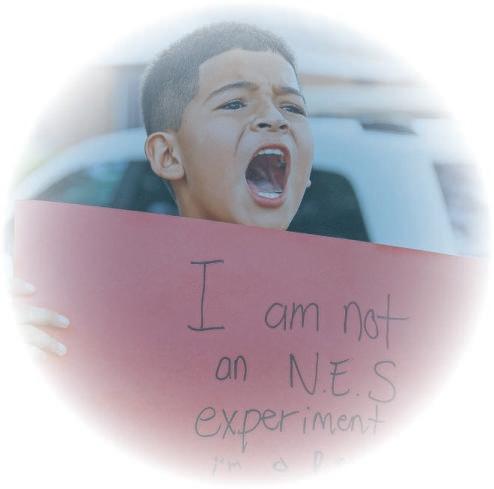 By Amaka Watson
By Amaka Watson
Dozens of parents gathered outside Cage Elementary School and Project Chrysalis Middle School on Sept. 27 to support teachers facing potential job changes due to the Houston Independent School District’s (HISD) new education system model.
The rally aimed to draw attention to the district’s recent actions, which have concerned many teachers about their job security.
The controversy stems from HISD’s move to terminate two teachers for alleged
insubordination, which has outraged educators and parents. The termination occurred three weeks into the new school year and has cast a shadow over the district’s commitment to its educators.

Dr. Luz Martinez, the Central Division superintendent, issued a stern warning during a recent meeting, stating, “If you’re one of the teachers who is refusing to do the model … you will not be here on this campus. I will reassign you to another place because we are not going to be fighting this battle all year long.” This statement left many teachers feeling unsupported and intimidated by the district’s administration.
Parents joined the rally to express their concerns about the district’s handling of the situation. A local educator, Juan Suarez, criticized HISD’s approach, saying, “What HISD is doing is corrupt. They want to set up schools for failure. We aren’t teaching; we are just regurgitating information from the slides. The activities aren’t fun or developmentally friendly for children.”
HISD Superintendent Mike Miles
said the purpose of this systemic reform model will improve academic achievement in struggling feeder pattern campuses, and the structured teaching instructions are necessary to make that happen.
Melissa Yarborough, an HISD parent, shared her worries about the impact on students, stating, “They don’t even finish the lessons in class, so my child sits at home, and I work with her until she understands the assignment in a different way. The problem is not the teacher; it’s the lessons they’re
making the teachers use.”
While Cage Elementary and Project Chrysalis Middle School primarily serve Hispanic populations, the concerns raised by parents resonate with those in predominantly Black schools facing similar challenges. Both schools had recently earned high ratings from the Texas Education Agency, and Project Chrysalis had received two National Blue Ribbon awards for its fine arts programs, meticulous coursework, and culture of college preparation.
The first arrest in the 1996 slaying of Tupac Shakur had its roots in the investigation of the killing of Biggie Smalls. The shooting deaths of the two hip-hop luminaries and rivals — Shakur in Las Vegas and Smalls in Los Angeles six months later — have always been culturally inseparable, and one man, Duane Keffe D. Davis, found himself involved in both investigations.

Defender News Service

Police wrestle the unarmed Black man to the sidewalk. One officer pushes his face into the pavement as he pleads in vain: “Can’t breathe.” Witnesses capture the scene at a dark intersection on their cellphones — one yells, “Hey! Stop! Oh my God, stop hitting him!” — and the medical examiner rules the man’s death a homicide. The story evokes images of George Floyd begging for his life under the knee of a Minneapolis officer in May 2020. But this wasn’t Floyd.
This is the story of Manuel Ellis, who died, hogtied and handcuffed by three Tacoma officers, nearly three months before Floyd’s death would spark an international outcry against police brutality. Ellis’ death became a touchstone for racial justice demonstrators locally but did not garner the attention of Floyd’s murder in front of a crowd in broad daylight.


Still, the trial of the officers charged in Ellis’ case is another example of video footage of a
violent arrest possibly playing a critical role in determining whether the police should be held accountable. It’s also the first trial under a 5-year-old Washington state law designed to make it easier to prosecute police who wrongfully use deadly force. Opening statements are expected this week in a trial that could last more than two months.
Ellis, 33, was walking home with doughnuts from a 7-Eleven on the night of March 3, 2020, when he passed a patrol car stopped at a red light. Officers Matthew Collins and Christopher Burbank sat inside. After a brief conversation, Burbank, in the passenger seat, threw open his door, knocking Ellis down. The officers, both white, tackled and punched Ellis. A third officer, Timothy Rankine, arrived after Ellis was already handcuffed, face-down, and knelt on his upper back as Ellis pleaded for breath.
Police claimed Ellis had tried to open the door of another vehicle, struck their cruiser and swung
his fists at them, but three civilian witnesses — a woman in one car, a man in another, and a pizza delivery driver in a third car — said they never saw Ellis attempt to strike the officers.
Video showed Ellis raising his hands in an apparent gesture of surrender and addressing the officers as “sir” while telling them he can’t breathe. One officer is heard responding, “Shut the (expletive) up, man.”
“The police version of events has always been taken as the gospel truth,” said Philip Stinson, a criminal justice professor at Bowling Green State University in Ohio. “And what these cases show us, especially when there’s video evidence, is that oftentimes the actual narratives of the police officers, whether in police reports, whether they’re testifying, are sometimes inconsistent with the video evidence.”
The Ellis family said they hope the trial will be a turning point “in favor of truth and justice.”
Davis was recently arrested and charged with murder, with prosecutors saying he ordered and masterminded the Shakur killing. Now retired Los Angeles police detective Greg Kading was assigned to investigate the slaying of Smalls — whose legal name was Christopher Wallace — and in 2009 interviewed Davis as a person of interest in the case. Davis had been at the party at the Peterson Automotive Museum that Wallace had just left when he was shot.
Kading had helped build a federal drug case against Davis to get leverage to compel him to talk to Los Angeles police, who to date have made no arrests in the Wallace case.
“He confesses to his involvement in the Tupac Shakur case, he gives all the details of how he and his co-conspirators killed Tupac,” Kading told The Associated Press.
Davis, who had immunity for what he said in his police interview but not what he said outside it, went on to divulge many of the same details in documentaries, on podcasts and in a tell-all 2019 memoir that would give new life to the Las Vegas police probe and help lead to his grand jury indictment.
“He has essentially talked himself right into jail,” Kading said.
Davis had long been known to investigators as one of four suspects identified early in the investigation. He isn’t the accused gunman but was described as the group’s ringleader by authorities at a news conference and in court. In Nevada a defendant can be charged with a crime, including murder, if you help someone commit the crime.
Davis, now 60, said in his memoir, “Compton Street Legend,” that he provided the gun used in the drive-by shooting.
Publisher | CEO Sonceria Messiah-Jiles
Strategic Alllance Clyde Jiles
Digital Content Manager Get Current Studios
Managing Editor ReShonda Tate
Associate Editor Aswad Walker
Education Reporter Laura Onyeneho
Sports Terrance Harris
Jimmie Aggison
Social Media
Jordan Hockett
Ad Executive Jodie B. Jiles
VOLUME 92, NUMBER 47 - OCTOBER 5, 2023 The














Tough National Black Voter Day (Sept. 15) has come and gone, Black Voters Matter (BVM) is going all-out to “Reclaim Your Vote.”
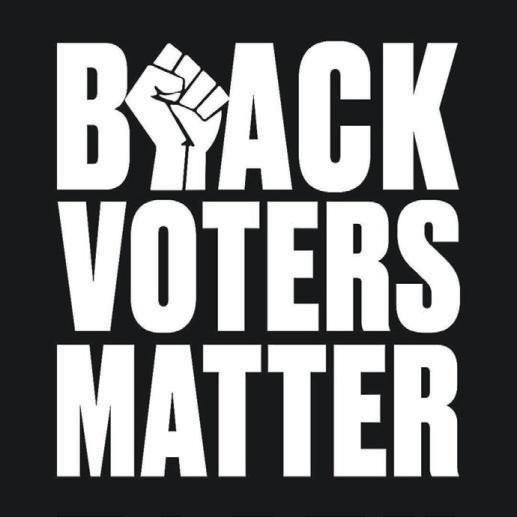
In partnership with BET Media Group and the National Urban League, BVM is hoping to encourage the participation of Black communities in voter registration and to ensure that the concerns of Black voters are heard.
“Partnerships like this help to energize our communities by keeping civic responsibility top of mind,” said Clif Albright and LaTosha Brown, co-founders of Black Voters Matter. “As we prepare for 2024, we must seize this opportunity to build power on the local level by encouraging people to get out and vote in local and statewide elections.”
Tis campaign is aptly called a “get out the vote” or “getting out the vote” (GOTV) campaign, which describes the eforts aimed at increasing voter turnout in elections. “Reclaim Your Vote” will run through Nov. 18, 2023 and aims to overcome “oppressive voter suppression tactics,” per a statement.
Te campaign will focus on seven statesLouisiana, Kentucky, Mississippi, New Jersey,
Ohio, Pennsylvania, and Texas. It will provide Black voters with digital resources on voter information.

“Teir [Black Voters Matter] timely and nuanced understanding of Black people and communities is precisely what this campaign needs to be successful,” said Brittany Packnett Cunningham, vice president of social impact at BET Media Group.
March 31, 1870, is etched in Black history, when Tomas Mundy Peterson of Perth Amboy, New Jersey, became the frst Black person to cast a ballot under the U.S. Constitution’s 15th Amendment. Tis amendment, which granted African American men the right to vote, was passed by Congress on Feb. 26, 1869, and ratifed on Feb. 3, 1870.
Despite this monumental milestone, the Voting Rights Act of 1965 was necessary to again make discriminatory voting practices illegal. And still, the right to vote for Black voters has encountered legal exclusion for years.
According to the Pew Research Center, the number of eligible Black voters were
projected to reach 32.7 million in November 2022. Tese voters also accounted for a high turnout rate of 51% (2018), more than Latino and Asian voters in the same year (40%). Additionally, eight states comprise around 50% of all Black eligible voters, led by Texas, with 2.7 million such voters.
Texas Republicans, who have control over the state legislature, allowed state authorities to supervise elections and gave the secretary
of state the authority to order “a new election” in the county if ballots in more than 2% of polling places are unavailable for more than an hour in Harris County, a Democratic stronghold with a population made up of a majority of people of color.
Te justifcation is last year’s precedent of the March 2022 primary, when about 10,000 ballots were not counted immediately in an election, the county faced a shortage in poll workers and ballots ran out in some places. Te elections administrator had then resigned.
Senate Bill 1750 and 1933 target Harris County in particular as it gives the governor-appointed secretary of state Jane Nelson more power to oversee elections and complaints, and to petition a court to replace election ofcials at her discretion.
Moreover, these measures were taken months before Houston’s mayoral race in November.
In 2021, Texas Gov. Greg Abbott (R) signed of on a bill that aims to impose criminal penalties for the violation of voting laws, banned 24-hour and drive-through voting and gave partisan poll watchers more access to election ofcials.
Some call us pioneers. Others call us surgeons. Nurses. Paramedics.

Saving lives in the middle of the night at a nationally renowned trauma center.


Delivering at-risk babies against all odds, from all across the county.
Year after year, training the majority of the doctors who practice in the most famous medical center in the world.
And, day after day, providing essential care and vital resources to those who need it most in every one of our communities.
You might not know our name. And that’s okay.
YOU’LL KNOW US BY THE WORK WE DO.

 By Aswad Walker
By Aswad Walker
Decades ago, the late comedy legend Richard Pryor commented on the criminal justice system, “If you go down there looking for justice, that’s exactly what you’ll find –just us.” And for Black and Brown folk, it’s been a criminal “injustice” system featuring over-policing, over-incarceration, longer sentences for the same crimes as whites, as well as never-ending police brutality.
But one of the biggest injustices is the lack of access to quality legal representation and all the negative ramifications that follow, particularly for Blacks, Hispanics and the economically challenged.
A foundational principle of the U.S. criminal justice system is that accused persons are innocent until proven guilty. However, over 555,000 presumed innocent individuals are detained pre-trial. Although the Constitution requires indigent individuals (people too poor to afford an attorney) be provided one, 314,000 people in Texas alone were appointed what legal experts call “mere shadows of proper representation.”

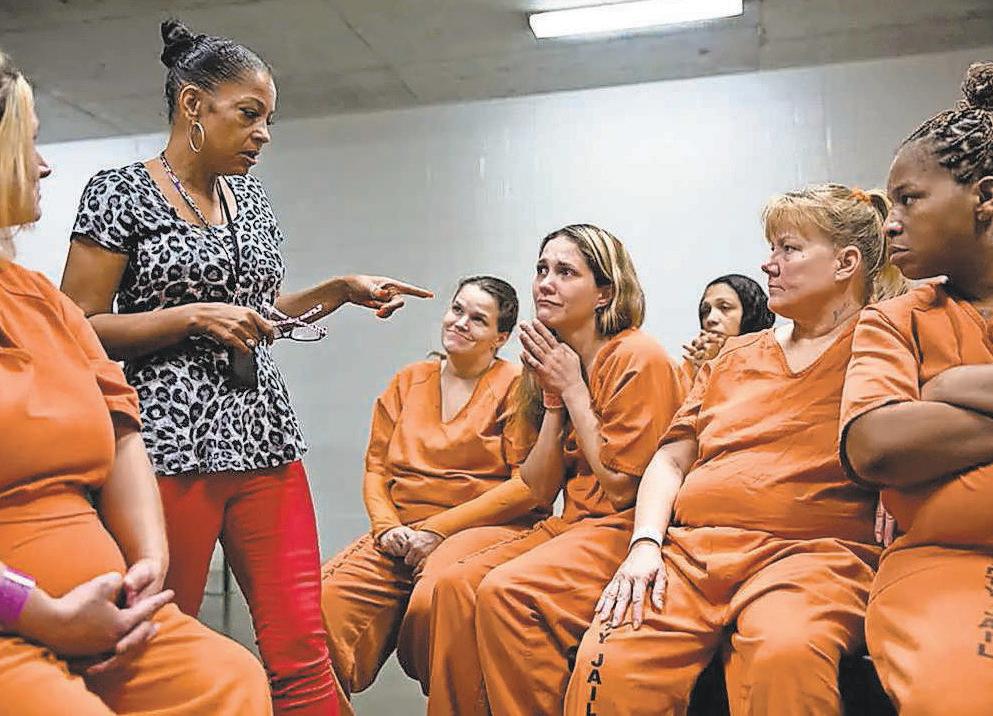
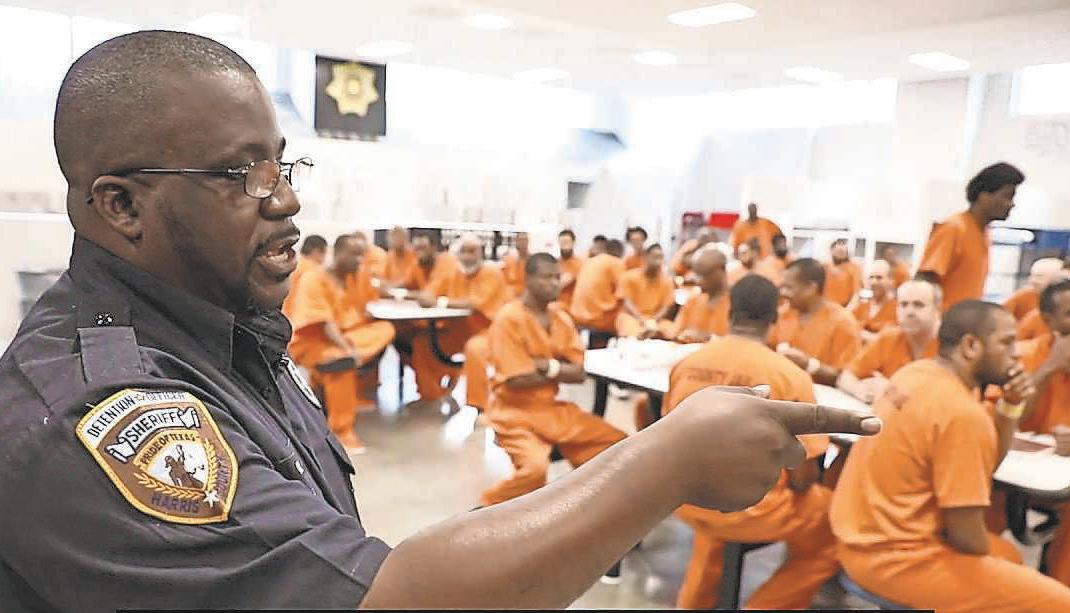
Here are some of the main problems for persons accused of a crime – and for society as a whole – when racial and economic disparities in access to quality legal representation are allowed to persist.
“If you’re accused of a crime and you can’t afford $40,000 to $50,000 [to pay for a lawyer] to prove you’re innocent, then the court system will appoint you one,” said Monique Joseph, holistic services director for Restoring Justice, a non-profit that provides “holistic and loving legal defense and social services” for individuals unable to afford adequate representation.

“Everybody has a constitutional right to have counsel, and that counsel has standards. They have to provide certain types of representation for folks. But oftentimes indigent defendants don’t get that same
representation.”
In Harris County, those who can’t afford a lawyer can get one through the county’s Public Defender’s Office (harriscountypublicdefender.org) or via court-appointed private attorney. The latter are typically attorneys who started their own law firms and are making top dollar via their bigmoney clients, but supplement their income, often greatly, by receiving pay from the Indigent Defense System for representing “the poor.” Roughly, 80 to 90% of indigent people are represented by a private attorney.
Joseph contends this reality is problematic because there’s neither oversight nor a support system for these private attorneys, many of whom fail to provide even basic representation for their clients while getting fully paid.
“Prosecutors have police departments, government crime labs, forensic experts to help investigate, while defense attorneys don’t have any investigators, experts, or assistants, and too often cases are resolved
without the defense engaging in any investigation. So, what we often see is folks stuck in custody, they bring them out for court dates and they sit them in this back room outside of everybody’s view. The attorney comes in and says, ‘Hey, they’re offering you a 35-year plea. You take it or go to trial and can get 99 years.’ The person’s like, ‘I’m not taking 33 years.’ And the attorney says, ‘Okay judge, reset for six months.’ And the attorneys never even come to court half the time,” shared Joseph.
“The lawyer comes out; he just hands another reset paper. There’s just nothing we can do about it,” said Ivory Lathan, who had been incarcerated for over 350 days with no trial.
One bright spot here, recently Harris County added Managed Assigned Council (MAC), but for misdemeanors only. If a client gets a court-appointed “misdemeanor attorney,” there is a body that makes sure the counsel does all the things required and expected from them.
Every year, more than 70,000 people charged with crimes in Harris County can’t afford to hire a lawyer. According to Joseph,
through the system. And when we take his case, he hates it. He hates the fact we come in and provide representation,” shared Joseph, who said one of the people Restoring Justice provided counsel for was a former Godinich client; a Black woman who suffered a mental crisis and got into an accident that unfortunately caused two deaths.
“This woman had a criminal record. She was represented by [Godinich] and sat in jail for three years [with no trial].”
Harris County’s current indigent defense system is set up to profit everyone but the individual needing legal defense.
“Attorneys donate to judges’ election campaigns. Judges then assign these cases to those attorneys, who make their money. Then the attorney turns around and gives the money back to that judge via more donations to keep them elected. That’s what we’re trying to prevent,” said Joseph.
Between 2004 and 2018, Harris County judges appointed attorneys who donated to their campaigns at double the rate, on average. This amounted to an average of about $17,000 per year in additional income for those attorneys, according to a 2020 Georgetown study.
And the more cases a lawyer gets, the more money they pocket. But it often doesn’t equate to more or better legal representation.
Jerome Godinich, allegedly known as Houston’s most overloaded attorney, handles roughly 360 felonies annually, more than double the caseload limit recommended by the U.S. Department of Justice (DOJ).
“We often take a lot of his cases because he’s notorious for making millions off of Black and Brown bodies stuck in the jail. He never goes to visit them. He plea deals people
According to Stephen Bright, a law scholar and Visiting Lecturer at Yale Law School, Johnny Ray Johnson and Keith Steven Thurmond were executed in 2009 and 2012 respectively, without having their cases reviewed because their court-appointed lawyer, Godinich, missed the deadline for filing their appeals.
“A lawyer who can’t file his papers on time should not be allowed to practice law. And yet he continues to be appointed year after year, to lots of cases,” said Bright. “Part of it is because he’s made campaign contributions to judges who, in turn, appoint him to cases.”
“The problem of a poor person accused of a crime, of course, they cannot afford to hire a lawyer. So, they’re really at the mercy of the system. They may be assigned a fairly good lawyer who represents them well. They may be assigned a terrible lawyer. And if they’re assigned a terrible lawyer, there may be nothing they can do about that,” added Bright.
In May, 1994, Dallas resident Richard Miles found himself heading to prison for murder. Te 19-year-old had been walking home when police arrested him, saying he ft the description of a man who had shot two men at a gas station in Dallas earlier.

Afer one witness identifed him and despite the fact that several other witnesses could not identify Miles from photos, Miles was charged with murder and attempted murder. Despite evidence he believes proved his innocence, Miles was found guilty and sentenced to 60 years behind bars, robbing him of the remainder of his youth.
“I ofentimes say, ‘May 15, 1994 is the day that Richard Ray Miles, Jr. died.’ I became a number – 728716,” Miles later told CNN.
He was released in 2009 but said he couldn’t do much until Speaking Truth helped declare him innocent in 2012.
“I’ve enjoyed both releases and the obtaining of freedom and just
afer that, I think society should just understand what we go through,” Miles said.
Miles said anger was one of the emotional stages he and other people who are wrongfully incarcerated experience.
“You begin this cycle of systematic living, anger creeps in, you’re upset with the attorneys, you’re upset with the prosecutor... And obviously, resentment, to a point where you’re looking at your life, and you ask yourself, what is the value? What is the purpose?It takes a person a higher level of connectivity to understand what you’re physically going through isn’t the end.”
In honor of Wrongful Conviction Day, which was Oct. 2, people across the country paid homage to those who had their freedom snatched away and highlighted the work still needed to be done within the justice system.
Founded by the Innocence
Network, a collective of organizations dedicated to ofering pro-bono legal and investigative services for those seeking exoneration, Wrongful Conviction Day aims to rectify the root causes of these miscarriages of justice while also providing support to the exonerated as they reintegrate into society.

Since its inception in 1989, over 3,320 wrongful convictions have been unearthed nationwide, resulting in a staggering cumulative loss of 29,500 years for those unjustly incarcerated. Today, it remains impossible to
ascertain the exact number of innocent individuals still languishing behind bars. However, experts estimate that between 2% and 5% of the nearly tw million incarcerated in the US are victims of wrongful convictions, indicating that anywhere from 40,000 to 100,000 people are presently sufering this grave injustice.
Recent studies show a 70% increase in wrongful convictions in the last fve years. Analysis of those cases showed race is a significant infuence in wrongful convictions.

in the United States 2022 examined 3,200 innocent people exonerated in the U.S. from 1989. Tey concluded that Black Americans are seven times more likely than white Americans to be wrongfully convicted of severe crimes. Tis applies to all signifcant crimes except white-collar crime.
Drug ofenses show the most significant racial differences. African Americans are 19 times more likely to be wrongfully convicted of drug crimes. Wrongfully convicted Black persons serve harsher sentences than innocent white people in all crime categories.
Organizers at The Innocence Network noted that this Wrongful Conviction Day is a rallying call to educate and disseminate knowledge about this pressing issue. Te Innocence Network, a loose coalition of independent innocence organizations, has remained at the forefront of the battle, working tirelessly to combat wrongful convictions globally and advocate for systemic reform in the criminal legal system.

You can’t talk about Houston Black history without bringing up the Turkey Day Classic, the football game between Phillis Wheatley and Jack Yates high schools. And though the annual Tanksgiving Day tradition only lasted for 20 years (1946 – 1966), the game’s impact lives on, both in the memories of Wheatley and Yates alumni and in a recent state recognition. In late September, the game widely considered one of the most significant high school football rivalries in Texas history, was recognized by the Harris County Historical Commission which unveiled an ofcial Texas historical marker for the Turkey Day Classic. Te marker resides on the University of Houston campus near the intersection of Cullen Blvd. and Cougar Place Dr., southeast of TDECU Stadium – the site that once was Jeppesen Stadium which hosted the Turkey Day Classic annually.
Jeppesen Stadium was renamed UH’s Robertson Stadium in 1980 before being demolished in 2012 to make way for TDECU Stadium, which opened in 2014.
UH ofcials served as hosts for those on hand for the marker’s unveiling, including




former Wheatley and Yates football players, drill team, band members and cheerleaders. As well, several local leaders and dignitaries were present for the festivities which included a luncheon along with the unveiling ceremony.
“As part of the Third Ward Initiative’s mission, the University of Houston strives to celebrate the history and culture of our shared neighborhood,” said Elwyn Lee, UH vice president for neighborhood and strategic
initiatives. “In pursuit of that goal, the University applied for the state historical marker to raise awareness about this incredible high school football rivalry. Te Turkey Day Classic truly transcended the gridiron to become a community spectacle that has been cherished for generations.”
Turman Robins, author of “Requiem for a Classic,” said the Classic evolved into more than a game, but an annual happening – a Turkey Day week –that included parades,

foats, fans dressed “to the nines,” an unofcial auto show and dances before and afer the game. Tis annual Black cultural phenomenon was known to attract as many as 30,000 people to the game alone, and even more to all the additional happenings.
Te historical marker unveiling planning committee included Lee, Debra BlacklockSloan (Harris County Historical Commission member and Wheatley alumna), Carolyn Moore Wright (Wheatley alumna), Jefrey Boney (president of the Jack Yates Alumni Association), Carl Davis (Yates alum), Sara Lujan Donatto (UH Ofce of Government and Community Relations) and Karl Hearne (UH Staf Council President-Elect).
“Unveiling the historical marker was a proud, historic moment for both alumni,” stated Blacklock-Sloan. “When I approached Dr. Lee about the idea in 2019, he was more than ready to collaborate on preparing the marker application and narrative which was a true labor of love for me as a Wheatley alumna. Harris County Historical Commission member Bernice Mistrot provided invaluable assistance, as did sports enthusiasts/historians Michael Hurd and Mike Vance.”

When Elizabeth Francis was born, there were only 46 states, 90% of Blacks lived in the South, and the world was only 45 years removed from slavery. Now, the 114-yearold Houston woman is being recognized as a supercentenarian for being the oldest Houstonian and Texan, and the second longest-living person in the United States.
Francis was recently honored on National Centenarian’s Day (Sept. 22) by Family Roots for Life, Inc. with the 2023 Family Roots Living Legend Award at the historic Heaven on Earth Event Center.
“We are honored to celebrate and capture the memories and experiences of Mrs. Francis and people who are 100 years old and older throughout the year in our Living Legends program,” said Atasha M. Kelley-Harris, M.Ed., CFLE, LCPAA, founding president and CEO of Family Roots for Life, Inc. “Tese senior adults are ofen the heartbeat of families bringing a wealth of knowledge, lived experience, and wisdom that inspires, encourages, and even contributes to their family’s or others’ wholeness physically, mentally, and emotionally.”
At 114, Elizabeth Francis is the oldest living person in Texas, second-oldest in the United States, number seven in the world, and number two in the world who lives at home.
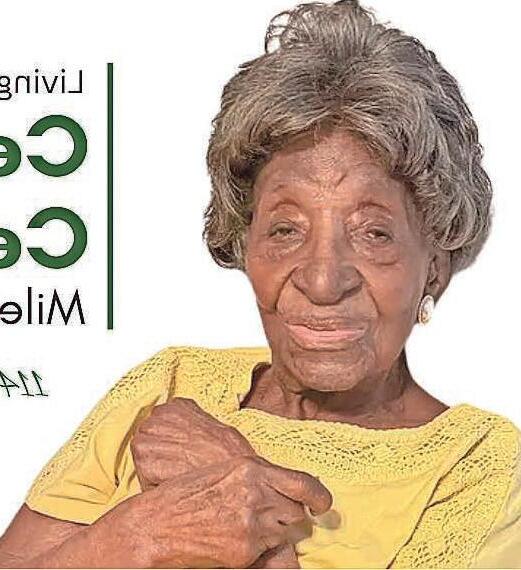
When asked, “How does it feel to be 114 years old?” Francis said, “I don’t know, I just thank the good Lord for keeping me.”
Francis’ long life seems to be genetic. Her sister lived to be 106, her daughter is 94, and her granddaughter and caregiver is 68.
Family Roots for Life, Inc presented the 2023 Family Roots Living Legend Award to Francis at its Girlfriend’s Gathering on Centenarians Day, Friday, Sept. 22 at the historic Heaven on Earth Event Center in Missouri City, TX.
Francis’ family accepted the 2023 Family Roots Living Legend Award on her behalf at the Girlfriends Gathering where attend ees celebrated the bonds of friendship, community, and service; and participated in a special project focused on empower ing and assisting newly independent teens and young people—especially those transi tioning out of the foster care and adoption systems—to prepare for life on their own as adults.
Te Family Roots Living Legends Pro gram celebrates individuals who have reached the age of 100 or older who reside in Greater Houston and nearby cities/towns. To have an individual recognized, send their name, birth date, and the contact phone and email address of the person submitting the request to us at info@familyrootsforlife.org. Visit www.familyrootsforlife.org
The Houston Independent School District is soliciting Request for Proposals (RFP) via the District’s electronic bidding portal. Proposers may login to view specifcations and submit their responses at the following link https://houstonisd.ionwave.net/Login.aspx until 12:00 p.m. (CST) Wednesday, November 1, 2023, for the following solicitation:
RFP 23-06-12 Horizontal/Vertical Louver Blinds and Installation.
Pre-proposal conferences via Microsoft Teams will be held in conjunction with this RFP. Information regarding dates, times, and instructions to receive a link
NOTICE TO BIDDERS
The Metropolitan Transit Authority of Harris County, Texas (METRO) is planning to issue the procurement documents listed in this advertisement.
IFB No. 4023000132: Central Store Fire Suppression System Rehabilitation. Solicitation will be available on or about 10/03/2023. Prospective bidders/proposers can view and download these solicitations by visiting METRO's website at ridemetro.org/Open Procurements. If you are unable to download the documents or are having difculty, please contact 713-615-6125 or email Contracts/Property Services at propertyservices@ridemetro.org.
HOUSTON DOWNTOWN MANAGEMENT DISTRICT
MARKET SQUARE PARK TURF & DINING IMPROVEMENTS
The Houston Downtown Management District (the “Downtown District”) will receive electronic proposals for Market Square Park Turf & Dining Improvements performed in Downtown Houston, Texas. Proposals will be received until 11:00 AM, local time on Tuesday, October 31, 2023, by the Construction Manager of the Downtown District. Proposals received after this time will not be accepted. Proposals are to be emailed to the Construction Manager, Dusty McCartney at dusty@downtowndistrict.org
Beginning Thursday, October 5, 2023, documents will be available at downtowndistrict.org/procurement.
A MANDATORY IN-PERSON Pre-proposal Conference will be held at 2:00 PM on Monday, October 16, 2023, on site at Market Square Park, 301 Milam Street, Houston, Texas 77002. All bidders are required to attend. Late arrivals will not be admitted to the Pre-proposal Conference. Proposals will be ruled nonresponsive if received from a bidder who did not attend the Pre-proposal Conference.
Bidders shall comply with City Ordinance 95-336 (March 29, 1995) and Exec. Order No.1-2 (June 14, 1995), and City of Houston Afrmative Action and Contract Compliance Division Minority/Women Business Enterprise (M/WBE) Procedures (June 1995). The successful Bidder will be required to make good faith eforts to achieve an M/W/DBE participation goal of 25 percent.
If you are unable to download the documents or are having difculty, please contact 713-615-6125 or email Contracts/Property Services at propertyservices@ridemetro.org.
A “New Paradigm” is in full effect at the University of Houston-Downtown (UHD), thanks to the cutting-edge leadership of the school’s new president climbed 15 points in a recent 2024 U.S. News & World Report Best Colleges rankings, but new programs and partnerships are opening the door to new opportunities for everyone connected to the institution.
Blanchard’s speech highlighted UHD’s strategic goals: increasing the number of undergraduate and graduate degree programs by 2028; boosting the university’s graduation and alumni participation rates; developing more community partnerships; and securing additional research opportunities through federal and state grants.
And as the elevated U.S. News & World Report college rankings reveal, the school is on the rise, thanks in large part to the implementation of “A New Paradigm,” the strategic plan Blanchard introduced over the past year.
“This past year, implementation of our strategic plan, a New Paradigm, was in full swing. Our primary goal has student success at its center,” said Blanchard, during his address. “Enhancing student success requires more than faculty excellence. It even requires more than robust academic advising and built-in career services. Through the restructuring of our student affairs department as the Student Success and Student Life Division, we can now more holistically address student needs.”
Accomplishments cited included:
• The opening of the Basic Needs Center, which granted emergency funds to 276 students at a value of $88.5K over the past six months, an increase of 350% in monetary value over the previous five months when the Center was only online.
• Major strides in student mental health care with more than 100 faculty and staff plus 50 UHD police officers trained in Mental Health First Aid and an increase in the number of counselors on staff to 6.5 licensed clinicians and five master’s level counseling trainees. (The University offered 3,406 counseling sessions in 2022-23, more than double the number of sessions the year before.)
• The restructuring of student advising, an enhanced Academic Recovery Program for students on academic probation, increased scheduling of bottleneck courses, and the addition of evening tutorial services. Degree plans and journey maps for each academic discipline were also created.
• A $259,000 grant from the National Science Foundation. Dr. Vassilios Tzouanas and his team in the College of Sciences and Technology are leading undergraduate students through intensive research in such areas as cybersecurity, machine learning and process automation.
• A $2.5 million grant to expand the College of Public Service/Department of Urban Education’s focus on educating bilingual students and another $2.8 million to support a bilingual e-library project, led by Dr. Irene Chen and Dr. Maria Bhattacharjee.
• $990,000 from the Cancer Prevention and Research Institute of Texas , secured by Dr. Angelica Roncancio of the College of Humanities and Social Sciences
to support primary prevention efforts to reduce HPV-related cancer disparities in underserved communities.
• $2.6 million in scholarships provided by the Ted Bauer Foundation over the last five years for undergraduates in the Marilyn Davies College of Business.
And according to Blanchard, UHD is just getting started.
“We will continue to increase partnerships and service-learning opportunities, and we will engage more broadly in undergraduate student research. We will
Enhancing student success requires more than faculty excellence. It even requires more than robust academic advising and builtin career services. Through the restructuring of our student affairs department as the Student Success and Student Life Division, we can now more holistically address student needs.”
LOREN J. BLANCHARD UHD Presidentalso increase credit-bearing internships, fellowships, and practica for undergraduate and graduate students. And in 2024, we will successfully renew our Carnegie Classification for Community Engagement.”
“That’s a big deal, but here’s an even bigger deal,” stated Blanchard. “We aspire to develop new degree programs, moving from 46 to 50 undergraduate programs and from 12 to 20 graduate programs by 2028. Through more programs that meet industry standards, we will increase UHD’s economic development.”

Check out UHD’s additional goals

Texas Southern running back Jacorey Howard, a product of Aldine, ran for 94 yards and scored three touchdowns to lead an attack that managed 568 yards of offense against Lincoln.



The Astros did it the hard way, but finally clinched their sixth AL West championship after sweeping the Arizona diamondbacks. The reigning World Series champions went into the weekend with both their playoff and division championship hopes up in the air. But now Dusty Baker and the Astros have a bye during the wild-card round and begin postseason play Saturday. “At the end of the day, we kept it within striking distance and put it together at the end, which makes it very special,” Houston general manager Dana Brown said.


Texans wide receiver Nico Collins had 168 yards and two touchdowns on seven receptions during the Texans 30-6 win over the Pittsburgh Steelers.
 By Terrance Harris
By Terrance Harris
Senior Brian Jenkins, Jr. heard the whispers about the Prairie View receiving corp and the lack of a lethal passing attack well before he arrived on campus.
Sure, the Panthers could run the football with quarterback Trazon Connley often leading the way. But a threatening passing attack they lacked.
“We took that as disrespectful,” said Jenkins. “We’ve got playmakers in the receiving room. Our receivers are some of the best players on our team, but to everybody outside it’s, `Trazon can’t throw the ball because he doesn’t have any weapons.’ But that’s far from the truth.”
CJ StroudDon’t look now but the Texans have won two straight games following Sunday’s 30-6 dismantling of the Pittsburgh Steelers at NRG Stadium. Rookie quarterback C.J. Stroud continued an impressive start to his career by throwing for 306 yards and two touchdowns with no interceptions or sacks. Suddenly, first-year coach DeMeco Ryans is looking like an NFL Coach of the Year candidate, and Stroud, the No.2 pick in the NFL Draft, is being mentioned as the leading candidate for Rookie of the Year. The Texans (2-2) will see if they can keep it going when they visit the Atlanta Falcons this weekend.
The Texas Southern football team, expected to be one of the top teams in the SWAC this season, finally got into the win column with a Homecoming victory.
Never mind the Tigers’ 52-7 rout came against Division II Lincoln University, a program most have never heard of and that dropped to 0-6 on the season. Sophomore quarterback Jace Wilson, who is now officially the Tigers starter after Andrew Body announced last week he is taking a medical redshirt year, completed 14 of 23 passes for 130 yards on the day. The Tigers (1-4) are off this weekend and return to action on Oct. 14 at Bethune-Cookman.
That certainly seems to be the case this season after second-year coach Bubba McDowell and his coaching staff made it a priority to improve the receiving talent during the offseason. They added players like junior college transfer Shemar Savage while jumping into the transfer portal and luring talents such as Jenkins from Alabama A&M, and Coby Cavil and Jahquan Bloomfield from Louisiana Monroe to upgrade the receiver talent.
As a result, the Panthers’ offense has become much more balanced with several receivers who are all capable of getting open and making big plays, which was not necessarily the case last season.
Junior Tre’jon Spiller, one of the holdovers from a season ago, has seen the difference in the receiving room this season.
“This year we really came closer to each other and actually bonded as a team,” Spiller said. “We decided to buckle down and hold up to our name, Top Flight. All of us being on board, all of us buying into the process, that just makes us take off from there.”
And take off, the receiving corp has.
The Panthers have one of the top receiving corps in the SWAC with Jenkins (8th), Spiller (14th) and Bloomfield (20th) all ranking in the top 20 in receiving in the conference. Jenkins, a speedy 5-foot-7 receiver, leads the unit with 11 catches for 244 yards, while Spiller is second on the team with 11 receptions for 211 yards and two touchdowns and Bloomfield has snagged seven catches for 134 yards and one touchdown in the Panthers’ first five games.
But it’s not just the top three receivers who are making the difference. Connley
has several targets to work with that also include tight end Dylan Domel, along with Savage and Cavil. So far this season, the Panthers have nine players with at least five receptions on the season.
Cavil, who has been injured off and on since arriving in the offseason, came up with a couple of huge plays in the win over Alcorn two weeks ago.
“They definitely did improve,” said Connley, who has benefitted by not having to run as much. “It’s just a lot of speed and more athleticism. The most important part is understanding the game, understanding coverages, understanding assignments. So that’s where we started coming together.”
McDowell has been pleased to see the talent in the receivers’ room elevated, but he still isn’t quite satisfied that they are making the most of their opportunities. There are dropped balls and missed opportunities that he wants to see cleaned up going forward.

“Trazon has been hitting them on the money for the most part, but now it’s about them coming up with the big plays. And we talk about it all the time, that somebody has to make a play,” McDowell said. “When they are in position to make a play, they have to be that guy and everybody knows who that
guy is. If you are that guy you are going to make that play no matter what.”



Receivers coach and passing game coordinator Reggie Moore, who is back for his second stint on The Hill, is in charge of developing the receivers to be the type of players McDowell wants. Moore believes in the group he has and thinks the unit can reach the level of the players he considers to be the standard – his group of Panthers from the 2015-17 teams.
“Our numbers aren’t where they need to be, but I think we have the potential to do it. It’s getting there,” Moore said. “We are going to be alright toward the end if we stay healthy.”
Bloomfield, a product of Seven Lakes in Katy, says the motivation that is pushing the receiving corp is the low expectations coming from outside sources. It’s been the spark that has gotten them off to a strong start.
“As a group within ourselves, we know we were doubted and there are a lot of people who are hating on us. So, we just decided to take it personal and that’s the same thing we are going to do the rest of the season and pretty much make it about us,” Bloomfield said. “As long as we hold each other accountable and if we come hard with the same energy every day, nobody can stop us but us.”
The Houston Lamar Texans have only given up 42 points this season in six games. The Texans are a perfect 6-0 overall, and heavy favorites in 6A Region III District 18. Last season the Texans went undefeated in district play but fell in the second round of playoffs to Ridge Point. This season, with a slew of talent on both sides of the ball, the Texans hope to go further.
“We’re going to state, we’re going to state watch, we’re going to state,” said senior cornerback Christopher Boykins.
Boykins is confident in what his team has to offer this season, and his gameplay reflects the skills of the NFL ballers he studies.
“My favorite player is JC Horn from the Carolina Panthers. I like his confidence. He goes on the field and plays like it’s the last play. He plays every play like he has something on the line,” said Boykins.
Boykins began his football journey when he was four years old. Like many other dominant varsity players in the Ft. Bend area, he played for the Fresno Gators, and then the Stafford Cobras before going to play at Lake Olympia Middle School.
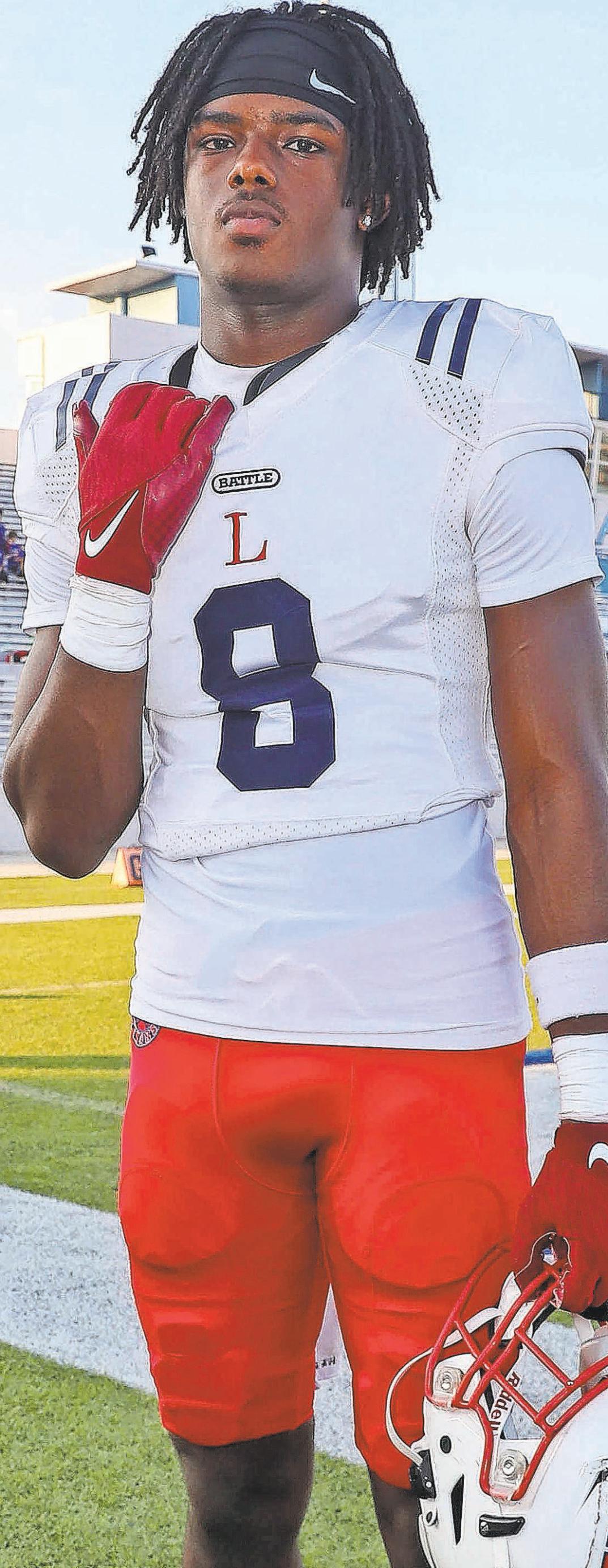

“On the Fresno Gators we all played: me, Jeremy [Payne], Zion [Kearney], the Drummer Brothers. We all played for the Fresno Gators,” said Boykins. “We all were just kind of running as a pack. Those were my guys.”
Prior to playing cornerback, Boykins played running back and wide receiver. Once he enrolled at Lake Olympia Middle School he switched to cornerback.
“My dad is kind of the reason why I’m playing cornerback because he forced me to switch,” said Boykins.
Boykins was hesitant to switch, but his dad, Christopher Boykins Sr., who played professionally for the Indianapolis Colts at the safety position, saw something at the time that no one else did.
During his sophomore season of high school, Boykins began to take the position seriously.

“Because I played receiver prior, I had a better understanding of who I was covering,” said Boykins. “I kind of know when the receiver was getting ready to break down, accelerate, or run his goal.”
During the off-season, Boykins dedicated himself to the cornerback position and began to focus on technique, with workouts

starting as early as 6:00 a.m.
“I worked a lot on staying in front of my man, and moving my hips,” said Boykins. “The offseason workouts allowed me to stay healthy and get stronger in the weight room. With me taking hits and doing the hitting, I have to make sure I’m strong at the top.”
Boykins continued to work hard in the offseason and walked away with the defensive back MVP while attending the Stephen F. Austin State University football camp.
“That was a great experience. Coach Trice, he’s an amazing defensive back coach. I really respect him. He gave me a couple of tips and I shut down everybody at that camp,” said Boykins.
Last season Boykins received second-team all-district for his play at corner, but this year the goal is first-team defensive player of the year.
Boykins hasn’t committed to a collegiate program yet but hopes to announce his commitment toward the end of football season. He currently has several schools after him, with the most recent being Navy, a few Power 5’s in addition to UPenn, Bucknell, and Brown.
“I’m looking for a brotherhood and the best school to graduate from, just in case the NFL doesn’t go as planned,” said Boykins. “While there I plan to study either communication and media or kinesiology; whichever one fits me.”
Class: 2024
IG: @chrisboykinss
Twitter: @boykins2312
Position: Cornerback
Height & weight: 5-feet-11, 165 pounds

Players he studies: JC Horn (Carolina Panthers), Sauce Gardner (New York Jets), Jalen Ramsey (Miami Dolphins)
Status: Uncommitted
Favorite artists: Ralo, NoCap
Favorite subject: Algebra
Shout-outs: Dad, mom
Te Social Justice Learning Institute (SJLI) has been dedicated to improving the education, health, and well-being of youth and communities of color. Te organization has remained unwavering in its support of social justice and equity, making a signifcant diference in the lives of young people and bringing more college readiness and workforce development opportunities to youth through its signature Urban Scholars and Higher Pathways program.
At the helm of SJLI-Houston is a dedicated team that includes Kimberly Upchurch, serving as regional director, and Jarett Fields, leading the charge as the educational equity programs director. Together, they’ve been instrumental in driving SJLI’s impactful initiatives forward.
Upchurch’s journey to her role as regional director at SJLI-Houston is marked by her deep commitment to serving marginalized communities. With more than two decades of experience working for a local nonprofit dedicated to homeless youth, she brings knowledge and empathy to her current role. A Houston native, Upchurch intimately understands the challenges and opportunities within the community. Her work shows her passion for advancing equity in education, healthcare, and justice for youth and communities of color.
Jarett Fields, SJLI-Houston’s educational equity programs director, leads one of the institute’s flagship programs—the Urban Scholars initiative. With nearly 15 years of experience in education, Fields has served as a middle school assistant principal, overseeing math, science, and reading courses.
Te Urban Scholars program takes center stage in SJLI-Houston’s mission. Its primary aim is to ensure that youth of color graduate high school and acquire the essential life skills and support needed to pursue higher education, vocational training, or gainful employment with a living wage.
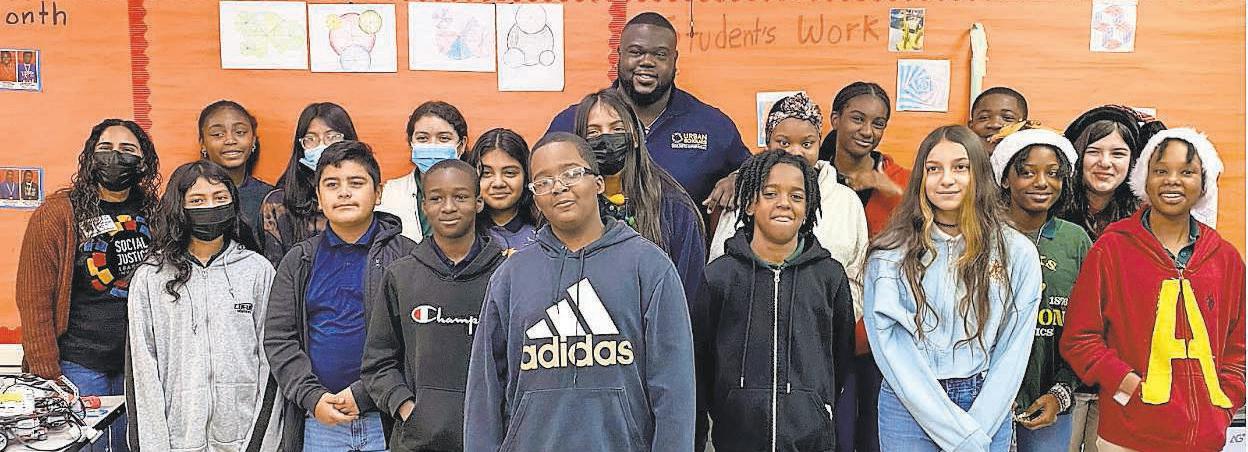
Recognizing the pressing need to uplif Black and brown alumni in education, careers, and fnances, SJLI introduced the Higher Pathways program. Extensive research underscores the critical connection between education, economic prospects, and wealth creation. Higher Pathways enhances SJLI’s services for opportunity youth aged 18-25.
Te program provides comprehensive support, including college access, retention assistance, workforce development, career pathing, employment aid, and barrier removal. It encompasses two primary tracks: College Pathway Success and Career Pathway Development, with another component—Pathways Supportive Services. Te Educational Attainment track covers essential aspects like college preparation, fnancial aid workshops, and family college planning.
Te Defender spoke one-on-one with Upchurch and Fields to learn more about the organization and their two education equity programs.
Defender: Howhaveyourbackground andexperiencesinfuencedyour approachtoaddressingBlackand Brownyouth’suniquechallengesin educationandcareeropportunities?
Upchurch: I’m a native Houstonian. I grew up in the Texas education system. I have two girls who’ve grown up in the education system and it has been challenging sometimes. It is hard to fnd equitable education opportunities for my own child[ren]. I’ve always worked in youth services and always tried to connect young people to higher education opportunities or to be gainfully employed. I worked at the Covenant House Texas organization for 21 years. We were a homeless shelter for young people. We did transitional housing and workforce development as well.
Fields: It’s the same type of factors that we see in so many other cities in Chicago, Milwaukee, and all these diferent places: violence, food instability, economic shortages, are [prevalent]. Tat helped me to begin to see why so many of the families that were in our schools were struggling economically. For parents, it’s not because they don’t know how to pick a school. All these parents are empowered. What we needed was an education system and programs that helped them begin to think through how we fght for something that we don’t see the injustice in all the time. For me, it
was leaning into education, seeing that there is a national problem, and Houston is tight-knit enough to begin to push for change.
Defender: Couldyouexplainthe signifcanceofengagingyouthin college-levelresearchduringhigh schoolandhowthisimpactstheir futureeducationalandcareerpaths?
Fields: For the students we serve, the need for more information is [a challenge]. Many of our students are frst-generation students. If you don’t have a household model or people close to you who can talk to you about college and how to navigate the process, this is where Urban Scholars and our staf come in. We help them throughout this process and introduce them to the resources they need to make the best academic decisions. Tis is a year-long conversation. It’s okay to dream. You can go to college, and money shouldn’t be a barrier. We have staf specifcally dedicated to that.
As for Higher Pathways, nationwide six-year graduation rates are extremely low. Now, people are seeing that a lot of kids are applying to college, but so many of them are not graduating. Tat creates a problem because of the difculty in getting back into school afer you’ve taken loans and all sorts of barriers. How do we take a student from sixth grade all the way through college, understanding that the Social Justice Learning Institute has supported them for that long? We hope to ensure that our students are graduating and fnding licensure or certifcation programs where they can sustain a family.